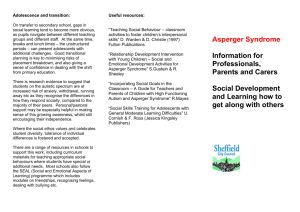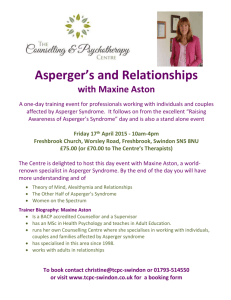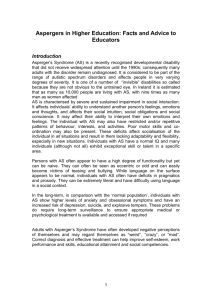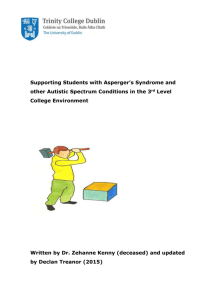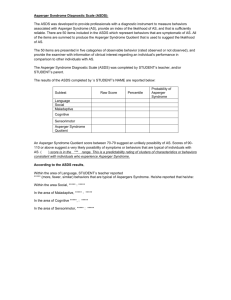Asperger`s Syndrome: Managing behaviour
advertisement
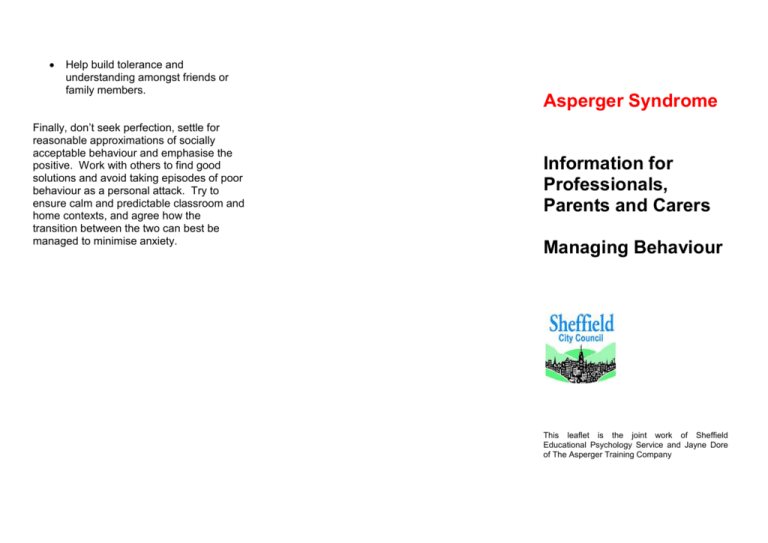
Help build tolerance and understanding amongst friends or family members. Finally, don’t seek perfection, settle for reasonable approximations of socially acceptable behaviour and emphasise the positive. Work with others to find good solutions and avoid taking episodes of poor behaviour as a personal attack. Try to ensure calm and predictable classroom and home contexts, and agree how the transition between the two can best be managed to minimise anxiety. Asperger Syndrome Information for Professionals, Parents and Carers Managing Behaviour This leaflet is the joint work of Sheffield Educational Psychology Service and Jayne Dore of The Asperger Training Company . Why does inappropriate behaviour happen? The nature of the condition means social communication, flexibility in thinking about situations and social competence are delayed or disordered (triad of impairments). Children and young people with Asperger Syndrome tend to: Be single minded in pursuing their own areas of interests Struggle to remain focussed and on track for longer than when the topic is not self-generated. Appear distant and detached. Be self-determined in pursuing own fixed interests. Have tunnel-vision; be preoccupied with self while failing to track/monitor what is going on around him/her at any one time. Find difficulty in “reading” social situations, so cannot take a flexible approach or find alternative solutions. What works best in managing behaviour? No single strategy, approach or idea will work for everyone or for all of the time. Behaviour difficulties occur in a social context – the most challenging area of functioning for those with Asperger Syndrome. For the most part disruption at home, in the community or in the classroom is a reflection of the personal vulnerabilities the child or young person with this condition. Adopting a number of basic approaches can help reduce risks of unacceptable behaviours. These principles include: As a consequence behaviour problems can arise due to: Recognition of being “different” which can lead to frustration Lack of motivation to stay on task and see things through High level of self-direction/interest to the exclusion of others needs or expectations. Lack of self organisation Misunderstanding of the intentions/behaviours of others Target (or perception of being one) for bullying or ridicule. Poor self-control and emotional regulation Anxiety and distress Frustration and mood swings . Aim for consistency and balance in dealing with inappropriate behaviours Look for triggers and modify the environment Set clear expectations about what is acceptable behaviour – build in visual prompts Give short, clear messages about what good behaviour looks like. Draw attention to good role models of others doing what they should Keep stress and distress under control through clear structure, rules and routines and monitor levels of sensory stimulation (see leaflet on sensory overload) Intervene early when anxiety or confusion is developing Plan carefully for any changes to the normal routine. Prepare, forewarn and build in lead in time to adapt. Meaningful involvement of all key adults – partnership working between home and school Understand that every young person is unique, value this diversity and avoid making global assumptions about having a condition like Asperger Syndrome. Anticipate potential difficulties and develop a plan to overcome or minimise these Look for creative solutions – accept different ways of achieving the same goals Protect the dignity of children and young people at all times – agree how to exit situations which are getting out of control
